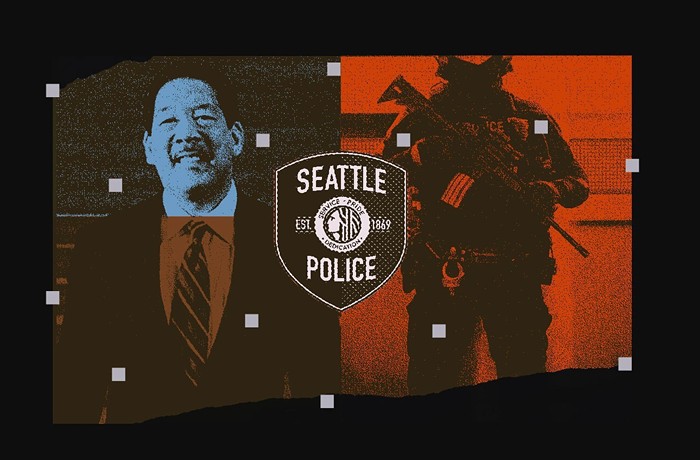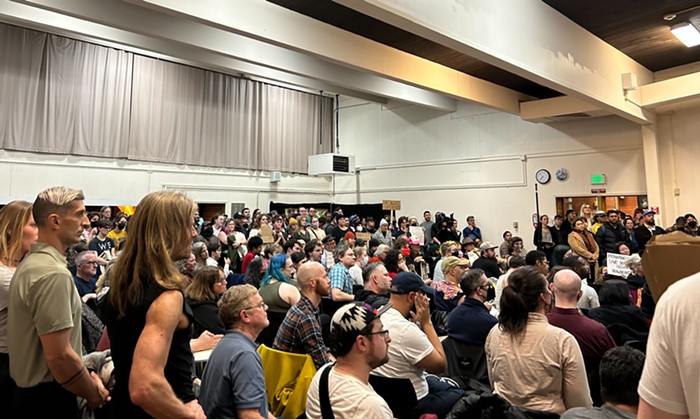"Choad, speed, powder, sprick-sprack, track, crystal," she recites for me. "It sounds like a religion, doesn't it?" She watches me take quick, microscopic notes in a stenographer's book. "You're a natural tweaker, honey, but if you hung out with me for one day, you couldn't keep up."
"How about an evening?" I suggest. She looks at me critically. "How about 10 minutes? Anyway, I'm hosting karaoke in a few hours. I'll give you a tour of the neighborhood, but right this very second I have to make a phone call. You have money don't you?" I hand 21-year-old Lauren a quarter and a dime. She picks them up like insect bodies between her silver nails. "Honey, I said calls. Hear the 's'?"
I hand her a dollar. "That's better. One thing speed teaches you about is human nature. For example, you don't trust me. But if this scene were reversed [she swirls her hands to show a switch]; if you had no place, needed some money--I'd give you that. You're family."
She waits for a response, then turns away, and empties the contents of her backpack onto the couch where she's sitting. Her legs are crossed. She looks like an obsessively efficient businesswoman with a tic. Lauren's logic follows its own askew compass. I think about a squirrel I saw just after it was hit by a car. It ran in wild circles trying to escape the orbit of its pain.
When Lauren comes back from the phone, she tells me, "It's time to go." I follow her out into the street. She mentions Guillermo, the friend she just called. Guillermo is mad, which worries Lauren, who's starting to crash and needs a fix.
Lauren wants to give me a drug tour of Capitol Hill, but first she needs cigarettes. We stop at a smoke shop. The man behind the counter recognizes her. Lauren takes me to the back of the store where there are several shelves of pipes in a glass display case. The pipes look like test tubes with metal bowls on the ends. I ask Lauren about the science of crystal; the chemistry, the equipment. "Stop romanticizing it," she responds, and turns back to the pipes. "Let me see this one, Gil," she says, tapping on the glass. Gil is watching sports on TV with the sound turned down. He sets a blue glass pipe on the counter.
While I examine it, Lauren tells a story. "I made meth before I ever did it," she says. Lauren goes on to describe how she was kicked out of her parents' house at age 14. Her mother called her a cunt; threw a frying pan at her head. As a kid, in first or second grade, she was put on asthma inhalants. Then she graduated to a nebulizer machine that looked ironically, she wants to show me, like one section of a meth lab. "Gil honey, you got a pen and paper?" Lauren asks.
The man brings a plain white sheet and a purple marking pen. She begins to sketch out a lab that looks like an elaborate mousetrap. Contrary to what everyone says, Lauren doesn't think meth is easy to make. She draws two kinds of labs--one on a table, a messy network of tubes and globes and spigots all heated with Bunsen burners. The other lab is in a bathtub. She crisscrosses lines to signify mesh or screens, and shows how the chemicals fall onto cookie sheets. "They stole this method from making acid," she says. "In this table method, chemicals drip into a jar. "That's your rent and paycheck." She points to a sketched glass at the end of the contraption. "You break that jar for the diamonds."
Cockroach
Crystal meth can be snorted, injected, eaten, smoked, or stuck up one's ass. It's made, or cooked, from combining chemicals of varying toxicity through a distillation process that involves heat and a scaffolding of tubes and flasks. Crystal induces euphoria, alertness, increased (if not obsessive) work performance, sexual stamina, weight loss, social ability, and confidence. It acts like adrenaline in the body. And it's cheap, running $20 to $30 per gram. A good high lasts from 12 to 15 hours, and users can stay up for days talking, working on a car engine, or cleaning the house, with little need for food. The downside of all this sleep deprivation is tweaking--heavy jitters and paranoia, sometimes even hallucinations--followed by a prolonged, sickening crash. Habitual meth users have been known to turn violent, although the relationship has been exaggerated by politicians and the media.
Each year since 1998, the number of crystal-meth labs busted in Washington state has doubled. In 1998, police found 349 labs. The next year, they uncovered 789, an increase of 126 percent. Federal drug-enforcement officers and local cops have spent millions fighting meth in Washington state, and they're looking to spend millions more: State lawmakers are trying to land a $15 million federal grant from the Department of Commerce to fund a statewide meth-fighting effort. But even with additional funds, police won't be able to get their arms around the drug, because they underestimate the resiliency and adaptability of the people who make it.
In fact, crystal makers are so crafty and determined, they can adapt to just about any conditions and work around any restrictions. Crystal meth is like a cockroach that keeps morphing, despite all the control measures state and federal officials use to contain it. If the cops stop up one hole, the cockroach comes out another. If they take away one food source, the cockroach figures out how to get the food another way.
Government controls are not only ineffective, they also make the problem worse. As crystal meth has morphed to escape detection, it's become more toxic and physically damaging to the people who use it; the soup of random chemicals becomes cut with other, more experimental chemicals. The drug also becomes easier to make, and more popular.
A crystal-like amphetamine substance was first discovered in Germany back in 1887. Synthesized in 1919, meth was used for a number of ills, including epilepsy, depression, and cerebral palsy. A person didn't need a prescription to use methamphetamines until 1951. It was considered a safe, low-risk drug. Various armies used it during WWII as a stimulant to get through their long days of fighting. After the war, the drug was prescribed for weight loss, asthma, attention deficit disorder, and narcolepsy.
Methamphetamine became more heavily regulated between 1965 and 1970, which pushed it underground. The first wave of illicit meth production and distribution was associated with biker gangs, who started up a cottage industry in isolated rural locations. During the '70s, the Hells Angels commandeered the trade, which was then centered in California. Meth infiltrated hippie and gay cultures in the Bay Area.
The Drug Enforcement Agency (DEA) was created in 1973 under the Department of Justice, and a national ad campaign, warning that "speed kills," was intended to quell the drug boom. Meth lost popularity during the highly policed Reagan and Bush years (when cocaine was, ironically, cheap) until its recent resurgence. There's a lot of speculation about what's caused the new crystal "epidemic," but you don't have to look far to see why it's popular. It's a business-savvy product--cheap to make, with a high margin of profit. It appeals to our culture, which is obsessed with weight loss and maximizing the use of time. Meth is also a sexual stimulant, and, perhaps, an antidote to boredom and depression among unemployed or underemployed blue-collar workers.
Circle
Lauren recalls her introduction to crystal. Her drug career started in Grants Pass, Oregon--she calls it Crank Cabin. "It's a conservative town, except for one street--G Street," she says. Lauren's first encounter with meth came when her friend Sabrina's mother asked the two girls to cut up lines on "a huge fucking mirror." That's where Lauren met the "white guys," friends of Sabrina's mom, whom she calls trailer trash.
Lauren moved in with the men after she was thrown out of her own home. She refers to them interchangeably as brothers, boyfriends, and fathers. "One moment they were abusers. The next moment I was the abuser," she says. They taught her isolated aspects of their crystal-making craft. She won't reveal details, and leaves on the table the implication of sex for shelter, the sense of dark refuge.
Lauren doesn't stay on one subject long. She draws another diagram, a circle within a circle. The middle she calls "insane." The outer ring is sanity. Drugs are one section of the circle; art, friends, and performing are other parts. Crystal is just one drug that keeps the circle moving. "Bud helps me when I'm crashing; sometimes pills," she says. "The point is to keep the circle moving, always moving, in order to stay outside of that insane center."
Cat Piss
The first "biker" generation of meth was made with lead, mercury, thorium nitrate, and phenyl-2-propanone (P2P). Labs were bulky, and the drug took a long time to cook. This manufacturing process, called the P2P or amalgam method, required at least crude chemistry skills, and was highly damaging to the environment. Chemicals used in manufacturing back then smelled like cat urine, which is why the product was known as cat piss dope. It was the smell that made labs easily detectable by police.
When the Chemical Diversion Act was passed in 1988 during the Bush regime, chemicals like P2P and the hardware and glassware to cook P2P meth became harder to get. Yet, instead of wiping out the underground industry, the laws caused an adaptive response that resulted in an even bigger crystal boom.
Cooks came up with new manufacturing methods, or recipes, built around two basic types of production: the red phosphorous method and the anhydrous-lithium reduction method, both involving the reduction of ephedrine, a common cold remedy. Red phosphorous, which is derived from flint and road flares, is used for bigger-quantity production. The anhydrous recipe--often called the Nazi method--produces mere ounces (the word "Nazi" here is arbitrary, and only adds to prevailing hysteria). Small labs are also called Beavis and Butt-head labs, Mom and Pop labs, or bathtub labs. The upshot is that crystal became more potent. The more virile version, which is what you find on the street now, is referred to by chemists as d-meth.
Government regulation also helped push meth to become more democratic. The ingredients for the revised quick-cook methods can be bought at local hardware or convenience stores: solvents, acids, camera batteries, cold remedies, fertilizer. Even the harder-to-get ingredients can be found at surplus markets and junkyards, where toxic chemicals are stored and traded.
As federal and state laws, including Clinton's Methamphetamine Act of 1996, continue to try to cut off availability of crystal ingredients, scavengers go to increasing lengths to gather chemical components. For example, highly volatile anhydrous ammonia (fertilizer) is often siphoned from big storage tanks on Eastern Washington farms into smaller scuba and storage tanks. Farmers have to worry about fires and explosions from tanks being poorly resealed. Scavengers also hoard lithium from camera and car batteries. Stories circulate about people driving up and down I-5, tearing lithium strips out of junked cars. Lithium is the crystal ingredient that researchers credit for heightened paranoid and psychotic behavior among users.
Ephedrine and pseudoephedrine are the most common, essential, and controversial ingredients in modern meth production. Ephedrine is the main ingredient in over-the-counter cold tablets, allergy medicines, and weight-loss pills. Uncle Fester, the anonymous author of Secrets of Methamphetamine Manufacture (a book that outlines various recipes for illegal manufacturing), says, "No aspect of meth manufacture has changed so radically in the past few years as the composition and availability of stimulant pills." Ephedrine has become a main government target in attempts to halt meth production. It used to be available from bulk-mailing warehouses and wholesalers, but the DEA cracked down, tracking big purchases and educating retailers.
As a result, Wal-Mart, 7-11, and other stores voluntarily report to authorities large cold-tablet purchases and lithium battery sales. Some meth cooks have turned to herbal ephedrine sources, like ma huang, a Chinese herb, which is easily acquired through health food stores. Contraband ephedrine in bulk can still be found on the black market, though. Law-enforcement officials believe it's being sold out of the backs of Asian convenience stores throughout Seattle.
Canada doesn't have the same tough drug laws we have in the U.S., so, according to Steve Freng, a prevention-treatment manager for the federal High Intensity Drug Trafficking Area office, ingredients like ephedrine are also smuggled across the border and transported to Seattle in the trunks of cars. In fact, border trafficking is so prevalent that Seattle has become a major wholesale and distribution point in the drug trade route. "Washington has become a source state for ephedrine going out," says Freng. "To some degree we supply the Midwest "
Holy Book
"Summit is the drug street and everyone knows it." Lauren talks and moves to a sprung beat, propelled out as if from a volcanic explosion of brain cells. "Labs, labs, all around us. Just like the bathtub one I drew for you. Let me see your watch." She grabs my arm and twists it. "Shit, we're late." Lauren outlines her code of ethics on our way back to Burger King. "Doing drugs, you're part of a family," she says. "There's trust among us. One day someone needs help. I'll provide it. If they fuck me over, I cut them off. Then they're rat-jacked. It's a form of debt payment," she says, then pauses when she sees me looking puzzled. "Like in the holy book."
Guillermo is waiting for us in his red Jetta. There are a lot of bike cops around the Burger King. Guillermo is pissed about the cops, about Lauren being late. I had expected him to be Latino. He's white; looks the way I ima-gine Lauren's Grants Pass guys looked. Grizzled; short, stringy hair; sallow cheeks; a broken-out face. He grips the wheel tightly and growls, "We're leaving."
"Can my friend come?" Lauren asks. Guillermo pulls Lauren toward him by putting his hand around the back of her neck. He whispers, "Jesus, God no, of course not." Lauren is still laughing when Guillermo opens the back door. His movements are jerky. "Guillermo thinks you're an undercover cop," Lauren tells me.
I get into the back seat beside Lauren. Guillermo glares at me in the rear-view mirror. Lauren kicks into entertainment mode once we're out of the parking lot. She does imitations of Celine Dion and Cher. Guillermo likes the distraction. He's wired. Checks his rear-view mirror excessively. Plays with the heat knob and the stereo volume.
"I need some pizza." Guillermo turns toward Lauren. She pretends to check her makeup in the mirror. She touches her lips. "Whatever, Guillermo. My friend isn't that stupid."
"Why are you being such a cunt?" he asks.
Lauren empties her purse on the back seat and starts sorting its contents again. "Girls don't usually do anything at labs," she tells me. "I do things like wash dishes. I don't let anyone come in the door." Lauren talks about the time Guillermo beat her up for tripping over and discombobulating a lab in a bathtub. Lauren recounts the story without emotion, as if she broke an established law and deserved punishment.
"I never hit you," says Guillermo, watching her in the mirror. He wants her to shut up. Lauren explains different ways to ingest meth. "With smoking, you get a little mini-rush," she begins. "You get an inward charge. It delivers a punch with power, but it's not like shooting it. Sometimes I play butch when I turn myself on. I put on a wife-beater shirt and a thick necklace. I load up 20 units in the bathroom. I don't like to fuck when I'm high. I like to organize. Where was I? Snorting. The good thing here is you're not murdering your lungs and not puncturing a vein. You get high quick. But I don't feel the choad until three hits."
"All of these methods," she makes sure I'm watching as she traces letters in the air, "spell S-L-E-E-P D-E-P. Everyone who plays knows the consequences. Drugs can also heal you. They can be a medicine. And then later--bock, bock," she folds her arms in a chicken gesture. "That's what happens when you come down. You cluck. You want more." Lauren puts her hand on Guillermo's shoulder. He startles. "How long you gonna make me wait, honey?" she asks.
"Be nice," he says.
"I hate nice," she snaps back. "You promise you'll take us back to Burger King later?"
Where the Labs Are
The buzz is that cooks learn their trade from books and Internet sites. But it seems more likely that recipes are secrets kept and passed down in distribution families. Labs are found in nice homes, bunkers, barns, sheds, motels, transit vehicles. Labs are packed away in large plastic storage containers, the kind always on sale at Eagle Hardware. The containers can easily be prepared for travel and just as easily abandoned. Police find containers full of lab paraphernalia in city and state parks, national forests, parking lots. Just about any place you can imagine.
Eric Neilson, a chemist with the Washington State Patrol, reports that two years ago, a meth lab was found in a semi on I-5. The truck was pulled over for a traffic violation. Meth labs are especially prevalent in rural areas, particularly Pierce County, which in 1999 had the third highest number of meth labs in the western United States (319), after Riverside and San Bernardino Counties in California. King County was second in the state with 107, and Thurston County was third with 86. Accurate statistics about meth users are as hard to pin down as the labs. According to the Washington State Division of Alcohol and Drug Abuse, there are 12,000 people in Washington state addicted to methamphetamine. (This statistic is probably low, as it's deduced from limited sources: treatment centers, arrest records, hospital entries, medical examiner reports, and lab-bust records.) In the last 10 years, there has been an increase of 800 percent in the number of people admitted to treatment programs for methamphetamine in Washington. Forty-seven percent of users are women, and the majority (91 percent) are white. The drug is commonly associated with gay men, homeless youth, and low-income people. But anecdotes suggest other types of users as well: housewives, college students, suburban teenagers, and high-tech tweakers.
Sally was part of the Pierce County crystal-meth circuit for years; it was her drug of choice from age 16 until she was in her mid-40s. She says crank families are "like the Mafia." Sally, now pushing 50, has big bones and a smoky, weary femininity. "A major dealer is at the heart of the family," she says. And around the dealer circles a motley group of users, cooks, and small-time dealers. "The biggest dealers have people that sell, steal, and buy for them," she explains. "Only a few people get to directly buy from the dealer."
Sally remembers living with Jessica and Vince. "Vince was the big dealer. I'd protect their place. Because I protected them, I always had dope. They didn't shoot up themselves, but they allowed me to, in their house." She's not a user now; she's wary of the new generation of lithium dope. "It makes people fucking wig out," she says. "You get really obsessive and paranoid. I was going to kill somebody once; shoot him when I was high."
"Lithium dope feels different in the body," Sally continues. "Your brain and body ache like you're having arthritis." She describes the abscesses, knots, and rashes suffered by a friend who's still shooting meth. "And there are weird things... one friend shoots up in the crook of her elbow and gets bruises on her wrist."
She recalls a pal named Jack, whacked out on lithium dope, who followed her to Puyallup in his car and ran her off the road, because he thought she was hiding his girlfriend under the front seat of her Datsun. "Cooking was the only risk back in the old days," says Sally. "The cooks I knew used to recruit young guys, get them stoned for days, and then teach them one part of the process and never let them meet the other people doing the other parts." It's a kind of security measure, ensuring that people won't make their own batches and steal the business. Sally's son and one of his friends used to cook meth in big glass Pyrex pans as large as cafeteria tables. They'd cook it for 48 to 72 hours, stirring and stirring with a big ladle, adding chemicals. The two got brain tumors after they added a jar of unknown chemicals to a batch of meth. They breathed the toxic mix for 72 hours.
Sally finally realized that the people she was hanging out with were not so much a family as a group of desperadoes. "People were deteriorating," she recalls. "Still we all hung together, because we had a feeling of worth together. We were all pieces of shit together."
Drug Money
Experts say treatment for meth, because of the incredible damage it does to the brain, can take up to two years. Meth alters a person's brain chemistry by mocking--and thus depleting--neurotransmitters, and by drastically changing seratonin levels, which can cause or aggravate mental-illness symptoms. But none of that really matters, because lawmakers and police are loath to fund treatment programs to begin with. Most funds go into lab detection and cleanup.
I witnessed these efforts firsthand when a meth lab three houses down from mine was busted last year. A sweet smell emanated from the lab in the mornings. Tough-looking, agitated people hung out on the porch. Trucks, vans, and even mobile homes pulled up at all hours of the night. The drug franchise operated for months, despite the fact that at least three cop cars per week stopped on our high-crime street. Then one day last June, the whole street was cordoned off with yellow police tape. A three-ring SWAT team circus took over: tents, fire trucks, ambulances, and a scattered collection of police cars. There were people in white space suits walking around. The place was transformed from a dumpy little rental house into a full-blown toxic waste site.
A few days after the "lab bust" died down and police quit surveilling the house, people climbed in through an open window and went back to cooking meth in the basement. Eventually, the place was boarded up. Now it sits waiting for an absentee landlord to fork over thousands of dollars to make it habitable again.
Thomas O'Brien of the DEA's Seattle office estimates that between $10,000 and $20,000 per site is spent on a big cleanup. When a meth lab is found, several agencies converge on the scene--the fire department, law enforcement, the Department of Public Health, and the Department of Ecology. If there are children present, Child Protective Services is called.
There is no question that meth manufacturing creates an environmental hazard. The method involves strong acids and flammable chemicals that, if breathed, can cause lung damage. There are also the dangers of upper respiratory problems, headaches, nausea, and liver and kidney damage. State officials view the matter with extreme caution, and Pierce and King Counties have their own law-enforcement emergency response teams just to handle meth labs. After police make a bust, an inspection takes place. Experts review the types of chemicals in the house. They check for spills and whether chemicals have been dumped down septic systems.
If the house isn't livable, a state public-health representative puts a red tag on the door. The building owner is told to hire a licensed decontamination officer to clean up the site. According to Jim Lockey, an environmental health specialist for Seattle & King County Public Health, it costs about $3,000 for a standard cleanup. For a really serious effort, an owner might be asked to pay as much as $25,000. Super-contaminated houses are burned down.
Dr. William O. Roberts, medical director of the Washington Poison Center in Seattle, shakes his head at all the expense. He believes that the state overhypes the dangers inherent in meth labs. "They've gone way overboard," he says. "It costs them $6,500 just to put on those moon suits." Roberts has lived through decades of drug and chemical hysteria trends. He sees crystal meth as simply the latest chapter. Besides the obvious political benefits, Roberts says meth hyperbole continues because the cleanup provides job security to hundreds of people.
Even explosions and fires, which Roberts calls the biggest real risks surrounding meth labs, are rare. Fires occur in only about .02 percent of meth labs found. "It's inappropriate to use these scare tactics when they are not founded on reasonable science," he says.
There's a sign in Susan Kingston's window at Stonewall Recovery Services that reads, "Tweakers welcome." Kingston is a refreshingly blunt, smart redhead from New York who majored in business, but found herself working with drug addicts as a volunteer. Later, she made it her career. She likes the frankness of addicts.
Meth users come to her office to get help with food stamps or to find housing. Despite limited resources and treatment beds, Kingston is proud of her work. For the past two years, she's seen 120 people per year. Every year, "30 to 40 percent of them went off speed," she says. "Some people take a year; some take two months. But I did all that on under $50,000 per year."
Roger Lake, an ex-law-enforcement officer who heads up the Washington State Narcotics Investigators Association, does not cotton to Kingston's meet-the-addict-where-they're-at approach. Lake favors more traditional tactics when it comes to battling the meth problem: "We like to win, being from law enforcement," he says. Lake's idea of proactivity--an idea he's been pushing in Olympia--is to hire more officers to detect labs and shut them down. He's softened the proposal with a request for 40 new treatment professionals to work with addicts who are arrested. (He proposes nothing for treating people who aren't on their way to jail or related to someone who is.) He's also included educational and health components, so he bristles when I call his plan police-based. "If we bust a lab," he says, "the bad guys would go to jail and there would be more treatment for the family." Although Lake calls his program "holistic," his methods follow the same cockroach-fighting "war on drugs" strategy that's currently failing. He just wants to spend more money: $15 million dollars a year.
Fixed
Guillermo stops in front of Pagliacci in the U-District. Lauren gets out of the car, but she doesn't go into the restaurant. She walks across the street instead. We drive around the block five times. Guillermo glares at me every few minutes in the mirror.
"Another frat boy," Lauren whines when she gets back into the car. "I hate them. Condescending assholes. But they know we have the best shit. I make them act polite." I notice that Lauren is amped up again. Her movements are abrupt, but underneath there's a steadier current. She offers me a cigarette, opens the window, and leans back like she belongs to the world speeding by.


















